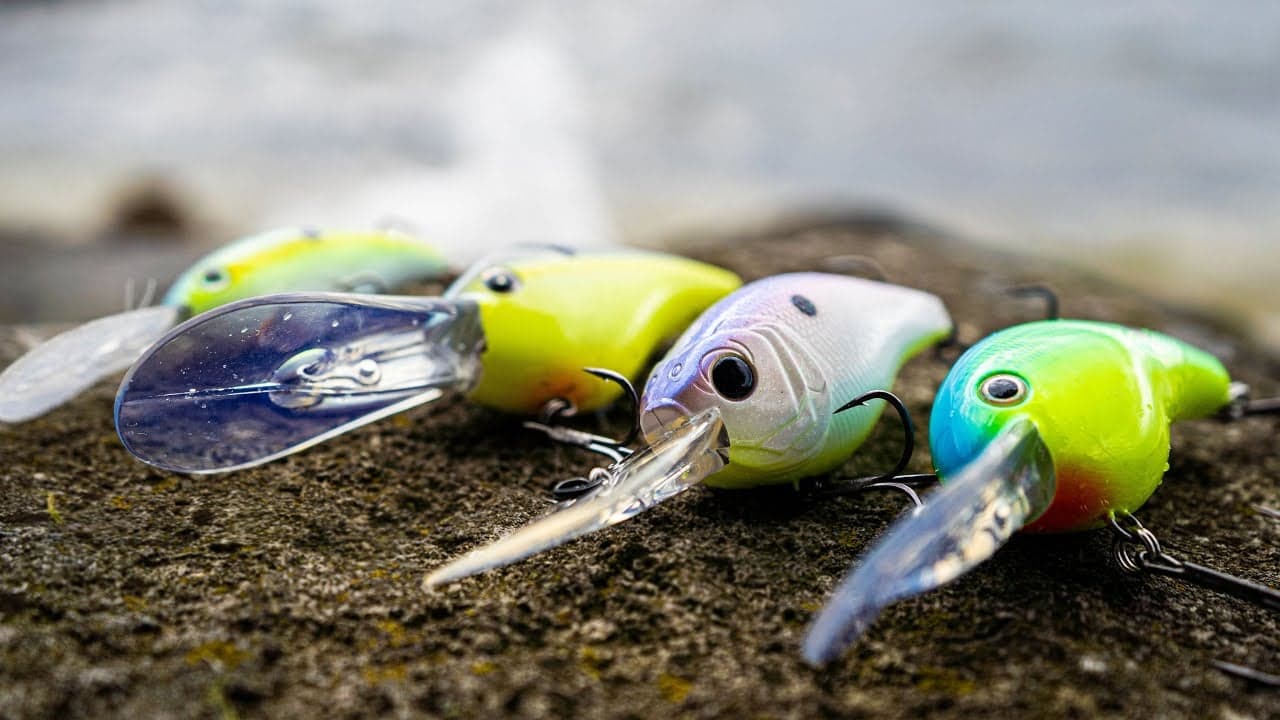Article by Tackle Depot Pro Staff Matt Duprau
Whether you’re south of the border, or here in Canada, there is no place where a deep diving crankbait doesn’t shine.
In the current boom of finesse presentations, such as the drop shot, neko rig, and ned rig, power techniques like deep cranking are often left under-utilized, leaving offshore bass more susceptible than ever. It goes without question, whether other presentations will trigger bass offshore, no other bait allows you to cover water and draw BIG bites like a big deep diving plug.
The Basics
Understanding how crankbait diving depth works will ultimately lead to better results on the water. There are several factors that can affect how deep a crankbait will run. The factor that is the easiest to manipulate can be applied before even setting foot at the boat ramp: line diameter. As a general rule of thumb, the diving depth listed on the package of a crank bait by the manufacturer is relative to the diameter of line, which is equal to 12 pound test fluorocarbon. Diving depth can be manipulated by either increasing the size of line, resulting in a more shallow running crank bait, or by using a smaller diameter line, resulting in a greater diving depth. Given its abrasion resistance, invisibility, low stretch, and fast-sinking capabilities, fluorocarbon is often the line of choice for many anglers.
One of the most important aspects of effectively fishing a deep crank bait, is achieving maximum casting distance. To the surprise of most, the window in which your crank bait is presented in the strike zone during a conventional cast is very narrow. The time it takes for a true deep diving crankbait to reach its target depth can equal up to 1/3 of your cast. Likewise, the bait will take equally as long to reach the surface of the water at the end of your retrieve. Casting distance is an imperative part of deep crank bait fishing, in order to maximize the duration of time your crankbait is presented in the strike zone and to achieve maximum diving depth. A key component that will contribute to maximum casting distance can be the use of a long parabolic rod. Personally, I prefer a glass rod stemming from 7’,6” - 7’,11” in length, paired on a low gear-ratio bait casting reel. The overall length of a moderate and slower action taper of a glass rod will pair in-conjunction to effectively load and launch the crank bait to its maximum distance. Casting reels that are geared at 5.4:1 to 6:2:1 will effectively handle the torque and resistance of a deep diving crankbait and make the turn of the handle less of a chore. Remember, while deep cranking, wind is your friend. Position yourself with the wind at your back and allow the wind to aid you in achieving a further cast.
Gear
Daiwa Tatula Elite Glass 7’,4” - 7,11” MH
Daiwa Tatula 150P 5:5:1
Strike King 5-10XD
Rapala DT 14-20
Berkley Dredger 15.5-25.5
How to Pick the Right Crankbait
Selecting the appropriate crankbait for depth and water colour can often be a daunting task. With thousands of models of crank baits available to anglers, it is easy to be overwhelmed with the vast expanses of colours and sizes. To make crankbait selections based on depth, a general rule of thumb is to pick a crankbait with a running depth 1-2 feet deeper than the depth you are fishing. This will allow the bait to maintain consistent bottom contact and effectively trigger strikes. Keep colour selection as simple as possible. The easiest way to do so is to assess the water clarity of your current body of water. If you are faced with dirty water conditions, turn towards brighter coloured crankbaits, such as chartreuse or solid white. In clear water, colour selection can be tailored towards the natural forage in the lake. A common phrase heard in bass fishing is “match the hatch”. Simply assess what the possible common forage is in the lake, such as bluegill, perch, shad or crawfish, and select a crankbait colour that pertains to your body of water.
Triggering Strikes
Crankbait fishing is often misinterpreted by many beginner fishermen and is sought out to be a “chuck and wind” technique. This couldn’t be farther from the truth. Although you will achieve strikes on a basic straight retrieve, your presentation will maximize its potential through both deflections, and sharp changes in speed to invoke reaction strikes. Many experienced crankbait fishermen would agree that the most vital aspect of triggering bass on a crankbait is through deflection off of hard cover. Whether you’re dredging boulders on bottom, working your crankbait through a deep brush pile, or ripping free of deep weeds, contact with cover is crucial. Don’t become stagnant during your retrieve! A sudden pause, or quick turn of the handle, can often elicit a reaction strike from an inactive bass.
Location is KEY
Finding the perfect location to utilize a deep crankbait is where many anglers tend to struggle and ultimately lose confidence. Offshore fishing, as a whole, can often be intimidating to both new and experienced anglers. In my opinion, success is often dictated by time spent behind the wheel. Points, humps, and ledges are all key locations to throw a crankbait and actively search for bass. With the advancement in technology, an angler’s “search” time can often be cut in half with the use of side imaging and contour lake maps. Locating high percentage structures on a lake map is a great starting point. With the use of side imaging, a large area of water can be covered to locate key subtleties on specific pieces of structure. These subtleties, such as rock piles, shell beds, weed edges, and hard bottom, are all high percentage fish-holding pieces of cover. After locating these high percentage areas, anglers are able to effectively make contact with these key pieces of cover, causing deflection and trigger a reaction strike.
TIPS
Have you ever had a crankbait run predominately to one side? Your crankbait is likely out of tune. There are a number of variables which may cause your crankbait to become out of tune. An easy way to identify this is by making a short cast and observing whether your bait follows a straight trajectory throughout the duration of your retrieve. If your crankbait is out of tune, simply bend the line tie on the bill of the crankbait in the opposite direction in which it is running. Less is more and it won’t take much to straighten out the crankbait. It is important to remember that all baits are not created equally and it is imperative that you test your baits out of the package and after replacing your treble hooks. A change in weight, or twist of a hook hanger can throw your crankbait out of tune.
“Upgrade your treble hooks”. We hear it time and time again, so why are so many anglers reluctant to change their hardware? If you truly want to become a successful crankbait fisherman, you must change your hooks. Although some companies invest more in their stock hardware, the majority of baits on the market come with sub-par hooks straight from the package. Semi-sharp, weak hooks will ultimately lead to an increase in lost fish. Bolster your results by investing in some quality round bend and EWG treble hooks.
Treble Hooks
Berkley Fusion19 Treble Hooks
Mustad KVD 1x Strong 2x Short Triple Grip Treble Hook
Owner Stinger ST-36

